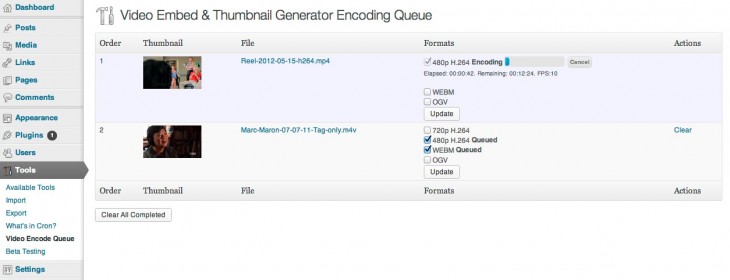The plugin can use FFMPEG or LIBAV to encode videos and make thumbnails if you have one of them installed on your server. You can choose to generate thumbnails and additional video formats automatically whenever a new video is uploaded to the media library, and there are buttons to generate thumbnails and additional video formats for every video already in the media library. If you want most videos to be re-encoded and replaced with a particular format but sometimes want to keep the original video, you can add the suffix ‘-noreplace’ (awesomevid-noreplace.mp4) to your filename and the uploaded video will not be replaced. Other automatic formats will still encode.
By default the plugin looks for FFMPEG in /usr/local/bin but if the application is installed in a different place on your server, you can point it to the correct place in the plugin settings. Users running WordPress on Windows servers should try using Linux-style paths (with forward slashes instead of backslashes and a forward slash / instead of C:). Multisite Super Admins must set the FFMPEG path in the Network settings page which will enable FFMPEG throughout the network.
If you have the proper libraries installed on your server, you can choose to replace your uploaded video with your preferred format, and generate as many as seven additional formats depending on your original source. 1080p, 720p, and 360p H.264, same resolution WEBM (VP9 or VP8) and OGV, and a custom format. Different browsers have different playback capabilities. Most desktop browsers can play H.264, and all modern mobile devices can play at least 360p H.264. If you create multiple H.264 resolutions, the highest resolution supported by the device will be served up automatically. The plugin will not upconvert your video, so if you upload a 720p video, it will not waste your time creating a 1080p version. There was a time when it seemed like a good idea to provide OGV or WEBM for some desktop browsers, but Firefox supports native H.264 playback in most operating systems now. I no longer recommend encoding OGV or WEBM unless you’re making an open source principled stand against H.264. However, your needs may vary. VP9 WEBM is a next-generation codec not supported by many browsers, but it can make videos much smaller while still retaining quality.
The files will encode in the background and will take some time to complete, depending on your server setup and the length and size of your video. VP9 encoding will take much longer than any other format. The plugin adds a Video Encode Queue menu to the Tools menu. You will see encoding progress, the option to cancel an encoding job, and you should get an error message if something goes wrong. Users on Windows servers may get inconsistent results with the encoding queue.
Encoded H.264 files can be fixed for streaming using “movflags faststart” introduced in recent versions of FFMPEG, or qt-faststart or MP4Box if you have one of them installed on your server and select it in the plugin settings. Without one of these options enabled, FFMPEG/LIBAV will place moov atoms at the end of H.264 encoded files, which in some cases forces the entire file to download before playback can start.


